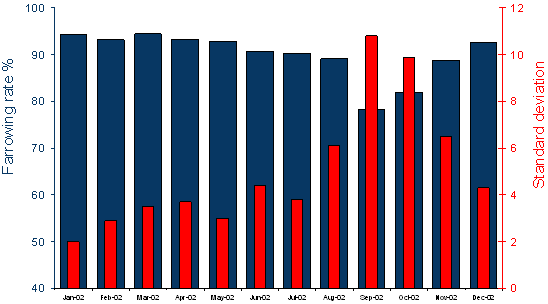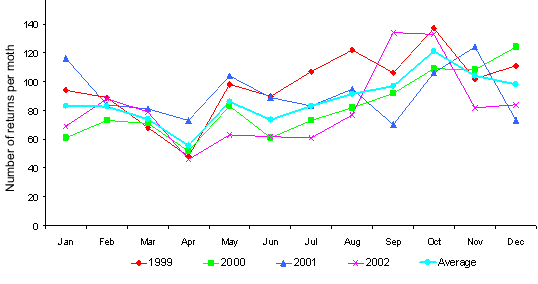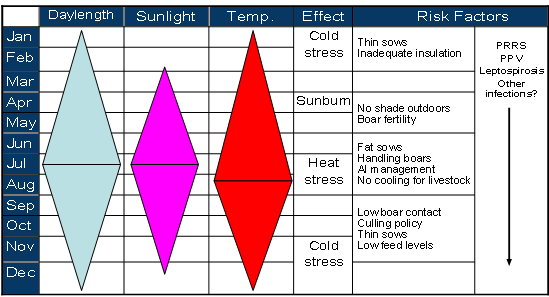The European wild pig is anoestrous from July to December. Oestrus cycles re-commence in late winter and are synchronised in the absence of boars. In natural conditions, there are seasonal fluctuations of availability of food and the earliness or delay in the onset of breeding is related to food levels. Synchronisation of oestrus is thought to be mediated via female pheromones which, in domestic pigs, are thought to antagonise seasonal infertility in primiparous and young sows as well as to synchronise oestrus in recently weaned sows. The mediator of seasonal infertility is melatonin but there is considerable variation in the results of experiments designed to demonstrate diurnal patterns of secretion. The effects of light intensity, the duration and the rate of change of the photophase, feed levels, physiological state and age will all have confounding effects. The highest rate of failure of pregnancy is associated with the rapid decline in daylight hours between late summer and autumn. Low blood progesterone levels occurring in autumn may lead to failure of maintenance of pregnancy. It has been shown that in September (in the UK), blood progesterone levels are significantly lower than at any other time of the year and at this time they show greater variation farm to farm, suggesting the influence of management practices.

Ultrasound scanning results from outdoor herds in the UK (n=11) illustrate this point well (above). Farrowing rate begins to tail off in March-April but at the same time the farm-to-farm variation increases. This suggests that factors other than changes in photophase and ambient temperature either exacerbate or mitigate infertility, the most likely being management of the microclimate and nutrition. Similar patterns are found in all pig producing countries.
Does high ambient temperature cause seasonal infertility?
The effect of high ambient temperature on fertility in pigs is controversial. Whilst there is no direct correlation, heat stress is known to cause high embryo mortality and abortion and it has deleterious effect on spermatogenesis and sperm motility. Because the provision of a means of cooling does not necessarily reduce the effects of seasonal infertility, it can be concluded that high ambient temperature is more likely to lead to reduced fecundity rather than reduced fertility.
High temperatures in late summer and a delayed effect from lower boar fertility can exacerbate seasonal infertility in autumn, but it may in fact be a fall in temperature in the autumn, without a compensatory increase in energy intake, that has a greater adverse effect on fertility than high summer temperatures.
Seasonal effects occur in indoor herds with a similar recurring pattern because sows kept indoors, regardless of climatic conditions, are generally subjected to the same changes in photophase that occur outdoors. The following figure shows the monthly numbers of returns to oestrus over four years in an indoor unit of 1200 sows in Southern England.

The failure rate begins to increase in April each year and rises steadily until October. There may be several factors contributing to this picture, which would include boar management and semen processing, as well as the effects of climate and photophase.
Seasonal effects on boar fertility and libido
There are also marked seasonal effects on the reproductive physiology of boars in terms of both sperm production and libido. Boar ejaculates contain significantly higher numbers of spermatozoa between September and February than they do between March and August. When the natural photophase was reversed experimentally between April and September, there was a corresponding increase in sperm production. Changes in photophase influence sperm production, whilst high ambient temperatures of 29ºC or above have a direct destructive effect on germ cells. It is therefore possible that the apparent onset of seasonal infertility in April, as measured by farrowing rates in sows, is due in part to a natural decline in boar fertility at that time. At least 5 weeks after the end of exposure of boars to heat stress is required before sperm motility returns to normality. Hot summer weather can therefore potentially render boars infertile until early October, thereby exacerbating any seasonal effect occurring in sows at that time. In addition, the libido of boars falls in summer and increases in winter.
Seasonal infertility – the combined effects

The diagram above brings together the main factors involved in seasonal infertility
Photophase, exposure to sunlight and ambient temperature reach their maxima between June and August. During the year, cold stress followed by sunburn, heat stress, declining photophase and possibly cold stress again with inappropriate conditioning of sows by feeding management will bring into play the various effects described.
Mitigation of seasonal infertility
All risk factors must be carefully monitored and controlled throughout the year if optimum breeding performance is to be maintained. Mitigation is dependent on:
• Identification and assessment of risk factors in the first quarter of the year.
• Commencement of specific mitigating procedures in April
- protection from sunburn in outdoor systems using wallows, shades, etc.• Maximum use of artificial insemination, either as a replacement for natural mating or as an adjunct to natural mating, especially between April and September.
- control of skin infections, especially mange, which might exacerbate sunburn
- enhancement of heat dissipation by creating draught, provision of wallows or cooling systems and reducing energy intake
- prevention of heat stress by carrying out animal handling procedures in cool times of the day
- protection from cold stress through adequate insulation, dryness and raised energy levels
- constant critical assessment of sow body condition with adjustment of energy levels and feeding programme
• Abrupt weaning of sows to enhance post-weaning oestrus
- avoid multisuckling• Mate at least 10% more gilts in the spring by adjusting the annual replacement rate accordingly.
- maintain a tight spread of farrowings within a group.
• Maintain good levels of boar contact during the first 35 days of pregnancy.
• Cull repeat breeders in August, September and October.
• Provide 16-18 hours of bright light in every 24 hours throughout the year.
• Separate gilts and possibly young sows from the main herd in early pregnancy.
• Maintain optimum age structure of the herd, bearing in mind that it is usually older, heavier sows that succumb to seasonal infertility.




